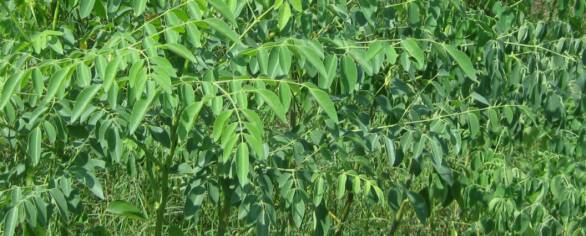We eat the flowers, the flower buds, the pods, and the leaves, but mostly we just eat the leaves.
If you click on the photos, you'll see just a few of the ways that we eat them, and suggestions. As an example - for PIZZA - simply add the Moringa leaves right at the end, or put them on top of the pizza sauce, and then put the cheese on top, and "mist" with a little olive oil and garlic salt - talk about delicious!
The first thing you need to have, is a source for Moringa. There are many fine companies who sell the Moringa Leaf Powder, online. For fresh leaves, it is best to grow them, yourself. There are a few places that sell the dried leaves, which reconstitute beautifully. If you can grow a Moringa tree, or several as a hedge, you can strip the leaves off the Moringa branches, and add them to your regular food. The QUICHE above, is one scrumptious way to eat Moringa - I know, men, you "don't eat quiche", but you might eat this one! It is made with fresh eggs, cream, cheese of your choice, fresh dill, garlic, diced onions, and fresh Moringa leaves. We just mixed all of those ingredients together, and poured the mixture into a pie crust, and baked it at about 350°F, until the crust was golden brown, and the knife we plunged into the center, came out clean.
If you have never eaten Moringa leaves before, you'll be pleasantly surprised at the "meaty" taste of the leaves, how well they combine with other foods and how good you feel after you eat them.
Another way that we really enjoy eating Moringa, is to add it to omelettes, or omelets - however you spell it, the dish is the same. The taste is just incredible. Moringa has a "pecany-spinach" taste - sort of like "nutty" greens. When the leaves are fresh, they have a slight "bite" to them; one reason that it is also called the Horseradish Tree. The root is also used, instead of horseradish, but we do not suggest doing that - you'll see why in the tips and warnings section. I cannot stress that part enough - leave the root - alone! When the leaves are cooked, or salad dressing is added to them, they lose their "bite".
Click on the name, to see one of our incredibly delicious MORINGA OMELETTES.
Do you like chili? Chili with beans, chili without beans, chili with meat, or chili without meat. Hot and spicy, or meek and mild - chili is always a hearty, filling, nutritious dish - but, it is better with Moringa leaves in it. You can also add Moringa buds, and Moringa blossoms to the chili, and if you have any fresh, small Moringa pods from your trees - chop them, and add them to the chili, too.
To keep most of the Moringa's nutrients intact, add the leaves, buds, or blossoms when the chili is finished cooking. Stir them in thoroughly, and let the chili "set-up" for about 2 minutes. If you are adding small, fresh Moringa pods, add them when the chili has between 3-5 minutes left of cooking time. They need just a bit more time, to cook through.
In addition to the added nutrition, Moringa adds "green" to the dish, which is a big bonus to the eye-appeal of your chili. We love it this way! Take look at our MORINGA CHILI...
Who doesn't like scrambled eggs? They tend to be bland in appearance, though, don't they? Well - look for "bland" no more, because the addition of Moringa leaves of any variety, "spice" it up, and make it look more appealing. Not only do the green leaves contrast starkly with the yellow eggs, they add additional usable protein, calcium, iron, potassium, magnesium and all of the essential amino acids to your scrambled eggs; not to mention Vitamins A, B1, B2, B3, C, and E. There is fiber in Moringa, too, which is another bonus, as eggs are not reknowned for their fiber content.
To your SCRAMBLED EGGS A LÁ MORINGA, you can add cheese, onions, mushrooms, bacon, sausage, ground beef, olives, green peppers, garlic, dill, chives, parsley, salt, pepper, or whatever suits you best - Moringa combines well with any of them, and more!
The best time to add the Moringa, whether you use leaves, buds, or blossoms, is right near the end of the cooking time, just like you do with Moringa Chili. If you are using chopped pods, add it to your beaten eggs, right when they go into the hot skillet. The pods just require a little more cooking time than the leaves, buds, and blossoms.
For the meatloaf lovers among us, here is another way to incorporate Moringa into your daily fare. Moringa combines well with any type of meatloaf you can imagine - even "meatless" meatloaf! Oh, I know that is an oxymoron, but it sounds odd to say that you are eating a meatless loaf. What are you going to call it? I call this, a MORINGA LEAF LOAF! Sounds just about right, don't you think?
Any form of Moringa can be added, to a regular meatloaf. You can successfully use the chopped pods, the buds, the flower blossoms, the leaves, or the powder - they will all absorb the flavors of your meatloaf's ingredients, and add some more valuable nutrition, in the process.
For meatloaf, just add any form of Moringa you wish, about ½ cup to 1 cup, to the ingredients that you normally use. Wait a minute! If you are using Moringa Leaf Powder, you'd better cut that back to about 3 full Tablespoons. That will be more than sufficient, to add taste and nutrients.
Check out our other dishes, by clicking on each of the photos above!
Moringa cooks quickly. If you sauté it, just cook it until it turns bright green, and wilts a bit. Do not overcook Moringa, in any form! As with most greens, it will become bitter, and lose most of its valuable nutrients. For the best taste, and nutrition, add Moringa leaves, buds, and blossoms, right near the end of cooking time for most dishes.
Start out with small amounts, as Moringa is a powerful energy booster, and it also very cleansing to the body. As with any natural cleansing products, "a little dab will do you". If you consume too much of any of the supplements, foods, or herbs that cleanse the blood, you may end up in the rest room for a long time, or throwing up the contents of your stomach. We love garlic, but eating too many bulbs of raw garlic can cause distress to the digestion system, so start slowy!
Moringa can be added to leafy salads, dips, soups, stews, chili, chicken and dumplings, macaroni and cheese, grilled cheese sandwiches, potato salad, fish dip, chip dip, tuna salad, chicken salad, ham salad, potatoes au gratin, grain dishes - such as rice, wheat, wild rice, quinoa, amaranth, chia, millet and teff. These are just a few ways to use Moringa leaves - the possibilities are endless!
For other ways to incorporate Moringa into your diet; see our OTHER LINKS or visit our other website at I Love Moringa, or just use your imagination!
~ ~ ~ HOW TO ADD MORINGA LEAVES TO YOUR DIET ~ ~ ~
Moringa Matters
< Back
WARNING - DO NOT EAT THE ROOT OF THE MORINGA TREE!
People DO, in many countries around the globe, but they are taking an incredible risk.
There is a neurotoxin in the root bark, which can be fatal, if taken in large enough quantities.
NO ONE appears to know the exact amount, so the best advice is - don't eat the root - ANY of it!
Pregnant mothers can eat the leaves freely, but there are indications that eating too many of the
flowers can have an abortive effect on the child she is carrying - so if you are
expecting, don't eat the Moringa flowers!
VARIOUS WAYS
TO EAT
MORINGA LEAVES
MORINGA INFO
MORE LINKS
Click
on the
photos
Click
on the
photos
Click
on the
photos
Click
on the
photos
This page was last updated: 9/1/2022
Moringa? What is that? Sounds like a dance, or something, doesn't it? No, it is not. That's a different word entirely. Moringa is an edible tree - literally. Most parts of the tree can be eaten, although the root should be left alone. We'll tell you why, in the tips and warnings section here. In India, and parts of Africa, the Phillipines, Guam, Haiti, and many other countries, the tree grows
freely in the wild. In the United States, it is just "coming into its own"..
Moringa leaves are a welcome addition to any diet, whether in its fresh state, or dried and ground into powder. For those who are fortunate enough to live in any area where the ground does not freeze in the winter, a Moringa tree can provide excellent nourishment year-round. Those who live in areas where the ground freezes, can still add Moringa leaves, to their diet, by growing it as an annual.



